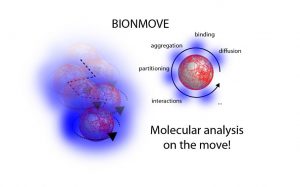
Subcellular, nanoscopic, dynamic structures or compartments, such as vesicles, organelles or entire cellular protrusions are key effectors of cell-life regulation. Yet, our ability to study their biochemistry in living cells is severely challenged by their restless, rapid movement in the 3D cellular environment.
The team coordinated by Prof. Francesco Cardarelli at SNS was able, for the first time, to bring state-of-the-art imaging and analytical tools on the trajectory of a moving, nanoscopic subcellular system. This is achieved by focusing an excitation light-beam in a periodic orbit around the nanostructure of interest. The recorded signal (e.g. fluorescence) is used as feedback to localize the nanostructure position with unprecedented spatial (nanometer) and temporal (micro-to-millisecond) resolution. The light envelope formed around the structure of interest (see figure) is used as a privileged observation point to push nanoscopy to an entirely new level.
The research has been performed at the NEST Laboratory of SNS by Filippo Begarani (PhD student at SNS), Giovanni Signore and Fabio Beltram, in strict collaboration with people from the IIT-CNI@NEST (Francesca D’Autilia), the CNR-Nano@NEST (Marco Cecchini and Ambra Del Grosso), the Laboratory for Fluorescence Dynamics at UCI, US (Enrico Gratton). Results are published in ACS Nano (link).
More in detail, the authors selected the lysosome as a target intracellular organelle. By using the orbital tracking approach, and exploiting the signal of a lysosome-specific environmental probe, they were able to probe the fingerprint of metabolic reactions ongoing in the lysosome lumen, during natural organelle trafficking. These appear as fluctuations in time of the lysosome-lumen polarity, a crucial physicochemical property. Begarani and co-workers demonstrated that polarity fluctuations are characteristic of living cells, depend on the organelle pH and metabolic energy, and are altered in a cellular model of lysosomal storage disorder (LSD).
“The physical revolution of the light beam proposed here – Cardarelli says – promises to drive a revolution in the way we address the natural, yet elusive, behavior of living matter at the sub-cellular level”.
